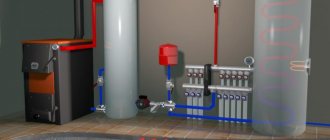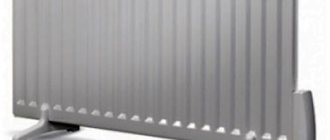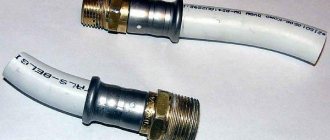What it is?
A heating element is a tubular electric heater. This is the main part of the water heater, with the help of which the required water temperature is maintained in the tank. This element converts electrical energy into thermal energy. As a result, the water is heated by the device to a certain temperature set by the user.
The work is that the thermostat receives electric current at the terminals, passes it through and transmits it to the terminals of the heater. The spiral heats up and transfers heat to the shell of the heating element, which heats the water. The device has a sensor that measures the water temperature. After reaching a certain indicator, the heating element with the thermostat turns off. After cooling down it turns on again. This is how the device works until disconnected from the network. Experts advise purchasing such a device from trusted stores.
Ariston heating element with a thermostat is considered one of the best. The heater contacts are silver-plated, increasing the design current to 25 amperes. This figure in other similar devices is no more than 18. The Ariston heating element with a thermostat quickly heats the water due to good heat transfer. The nichrome spiral has a high stretch coefficient. The devices are easy to install, light in weight and compact in size.
Installation of heating elements
Before installing the device, it is necessary to make power calculations taking into account the type of battery and the average thermal characteristics that are the norm in the given area.
Making calculations
When determining the power indicator, you can use the average value of thermal data in the Russian Federation. Thus, when installing a tubular-type electric heater as the main heating device on 10 square meters, a power of 1 kilowatt is sufficient.
For radiator heating elements that are supposed to be installed as an addition to the main heating system, it is recommended to use a power rating three times lower.
The rated power of an electric heating device can be calculated according to the formula:
Composition of the heating element
The heating element includes the following parts:
- A tube that can be copper, steel, brass, titanium. All types have different performance indicators. You should choose a device that is resistant to corrosion. There must be a protective layer on the walls of the tubes.
- A spiral made of wire that has a high resistivity.
- Filler that does not conduct electric current. Periclase is usually used. The filler serves to separate the coil from the tube.
- The contact rod is an element for connecting the heater to the network.
- The insulators are made of porcelain and are located at the ends of the tubes.
- Tubular shell.
- Sealant.
- Thermal sensor that regulates the water temperature.
Criterias of choice
When selecting a heating element for a radiator, you should take into account its technical characteristics, as well as the parameters of the battery. The main factors influencing the choice of device are:
- Power. In rooms with good thermal insulation properties, heaters from 2 to 3 kilowatts can be installed. In older buildings, it is best to use heating elements with higher power.
- Length of the electric heating tube. It is recommended to purchase heating elements ten centimeters shorter than the battery. Correct selection of the length of the heating device allows you to evenly heat all sections of the radiator.
- Battery Type. In order for the heating element to optimally fit the radiator, you should carefully study its technical data sheet. It specifies which types of batteries the product should be used with.
- Automatic control. Not all models have this option. For ease of use, it is best to purchase heating elements with automation, which are equipped with a thermostat.
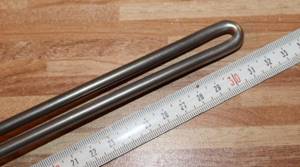
The heating element should be ten centimeters shorter than the radiator
The diameter of the electric heater is also taken into account in accordance with the cross-section of the plug on the radiator. It is important to correctly determine the placement of the thread.
It is necessary to purchase only high-quality heating elements from trusted manufacturers. Before purchasing an electrical appliance, you should check its integrity and serviceability.
Types of thermostat
This device comes in:
- Sterzhnev. Located in a tube on the heater body.
- Capillary. The tube contains a liquid whose object depends on water.
- Electronic. Responsive to temperature changes.
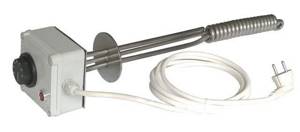
There are also electromechanical thermostats. Their work depends on the properties of biometals. The functions of the devices are simple, dual-zone and programmable. Judging by customer reviews, the most frequently purchased ones are electronic ones. They are easy to use and affordable. Although the choice often depends on personal preference.
Types of tubular heaters for radiators
Despite the simplicity of the design, you can find various variations of radiator heating elements on sale. First of all, the power of heating devices varies. Models with a minimum power “produce” about 0.3 kW, with a maximum – 6 kW.
The devices differ in the design of the housing. Considering that the configuration and location of radiators can be different, there are heating elements with left-hand or right-hand threads.
The diameter of the device may also vary. This is due to the cross-section of the radiator plug plug, in the place of which the device is mounted. Standard size is 40 mm.
There is no fundamental difference between devices intended for installation in radiators made of different materials. Their design is similar, only the diameter may differ. You can find single and double heating elements on sale.
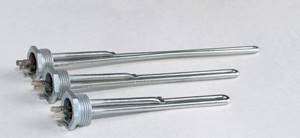
Double heating elements are more convenient to use. They allow you to significantly increase the rate of heating of the coolant, but at the same time they differ from single analogs at a higher price
The latter is more convenient to use. At the moment of switching on, both elements are activated at once, due to which the coolant heats up as quickly as possible. After this, one of the elements is turned off, which allows you to save energy resources. Some models are equipped with additional functionality.
The manufacturer uses only two functions:
- Turbo heating . Makes it possible to maximize the increase in temperature in the room. A thermostat is necessarily built into the device, which allows you to change the heating intensity.
- Antifreeze . This mode allows you to prevent possible defrosting of the entire system when the temperature drops to negative values. The heating element automatically maintains the minimum permissible temperature, while consuming a small amount of electricity.
In addition, radiator heaters vary in length and the presence or absence of a thermostat.
Types of heating elements
A heating element with a thermostat may differ in:
- Constructions.
- Installation method.
- Material.
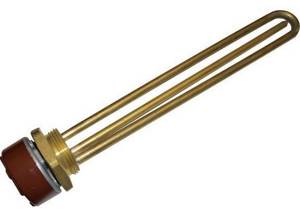
The shape of the equipment can be straight or curved. Experts advise focusing on the design of the room where such a device will be located. According to the composition of the product design there are:
- Tubular. This is a metal tube with a conductor. Inside there is dielectric sand, which serves as an insulator.
- Closed. Dry is in a protective flask. The space contains special oil or quartz sand. This model does not come into contact with water.
According to the installation method, the heating element with a thermostat can be flanged with thread and nut. Copper and stainless steel are used in production. In dry type devices, magnesium silicate is used, which is used to obtain the flask.
Application
A water heating element with a thermostat is used for various purposes:
- Heating. The device is installed in the battery using a connector. It should not be used for constant heat generation.
- Heating water.
- Water supply to showers, sinks, sinks. For these purposes, the device is installed in a ready-made container.
Experts advise using the equipment for its intended purpose if you want it to last a long time. The rules for its use are usually indicated in the instructions.
Scope of application of heating elements for heating
Electric heating elements have gained popularity due to their versatility and high efficiency. All the electricity they consume is used for its intended purpose - heating the surrounding space.
The main heating devices where heating elements are used are:
- Portable and stationary oil electric heaters.
- Water heating radiators.
- Bathroom heated towel rails.
- Electric fireplaces.
- Electric convectors.
- Electric boilers.
The specified equipment can be used as a main or additional heating source. It is inexpensive, easy to install and does not require special skills to operate.
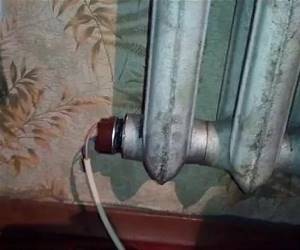
You can connect the heating element to a cast iron central heating radiator after disconnecting the common riser. This device can be used for main and additional heating
How big is the benefit from heating elements?
If you have an old battery, then why not use a heating element to turn it into a heating system for a small utility room - a chicken coop, a workshop, a garage.
There are even myths that heating with heaters is beneficial. But “dreams are shattered by harsh reality” - heating with electricity is the most expensive. Since the most expensive energy carrier is used.
It doesn’t matter whether there is a proprietary programmable electric boiler, or a barrel with a heating element lowered into it on a wire, the efficiency of such electric heaters is about 97%. And then we pay according to the meter...
Advantages
A water heating element with a thermostat has the following advantages:

- Safety. This applies more to dry heating elements. No short circuit or electric shock possible. This is achieved thanks to a design that does not involve contact with water.
- Long service life - over 15 years. The main thing is to follow the rules of use.
- Economical. This is due to the presence of a temperature sensor that regulates the supply of electricity.
- Easy to install. The heating element must be installed in the water heater, which is fixed on brackets. Then everything is connected to the network. The boiler has all the necessary controls.
- Several thermoelectric heaters can be used in one heater.
- Resistance to mechanical damage.
Heating elements for heating radiators: comfortable heating
An efficient building heating system that operates in an economical mode - many property owners strive for such a heating arrangement. Regardless of financial capabilities, they all want to live in warmth and comfort in a comfortable environment. A heating element for heating a house is an alternative solution to the problem of heat supply in private households.
What is a heating element for heating?
Electric heating elements for heating are heating elements that heat the coolant fluid circulating inside the radiator. They are installed on electric radiators made of different materials and alloys - cast iron, aluminum, etc.
Heating elements for heating radiators differ in that they are easy to use - the device is screwed into a special socket on the battery, which contains coolant inside, and connects it to a source of electricity. This heating device includes a protective casing and a thermostat.
The casing that covers electric heating elements for water heating prevents liquid from entering it and protects people from contact with electric current. During manufacturing, these heating devices are subjected to galvanization (a process of chrome and nickel plating), as a result of which they are durable and reliable.
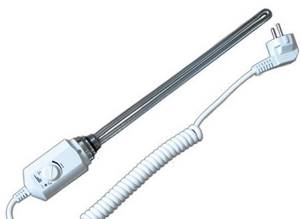
The capillary thermostat, which is equipped with heating elements for heating radiators, allows users to regulate the heating of the coolant, and thanks to the presence of two temperature sensors, the device is protected from overheating.
Electric heating elements may have additional functions, for example:
- “Anti-freeze” - helps maintain a minimum temperature (about 10°C) and prevents the coolant from freezing in the battery;
- “Turbo” - a heating element with a thermostat for heating radiators, after switching on, operates at maximum power and thus the room warms up to the desired temperature very quickly.
Scope of application of heating elements
You can use a heating element for a heating radiator (shown in the photo) when installing autonomous heaters simultaneously with a centralized heating system in order to provide additional heating of the coolant.

Most often, the decision to install a heating element in a battery is made by property owners if the heating in an apartment or house is unstable or is often turned off. This heating device is a good alternative that prevents the building from cooling down and the batteries from defrosting.
Advantages of heating elements
Heating elements (heating elements) have many positive characteristics:
- economy and efficiency - when converting electricity into heat, there is practically no energy loss;
- simple installation - you can even install a heating element for a heating battery yourself and for this you do not need to obtain a special permit from various authorities. Each device is accompanied by detailed instructions from the manufacturer, explaining the connection procedure and operating rules;
- durability - it is achieved through chrome and nickel plating;
- compactness;
- safety;
- A heating element with a thermostat for capillary-type heating allows you to regulate the temperature with a high degree of accuracy;
- save energy consumption by allowing the device to operate in pulses;
- affordable price;
- availability of additional functions.
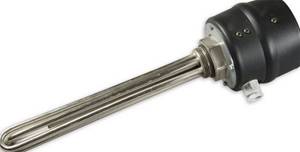
In addition to its positive qualities, a device such as a heating element for heating batteries has several disadvantages:
- high cost of electric heating of residential premises due to electricity prices;
- Not in all settlements throughout the country the electrical power from the substation allows the use of these devices.
Correct choice of heating element model
When going to purchase a heating element, the buyer needs to know a number of technical characteristics:
- required power of the device;
- length, diameter and shape of the tube;
- length of the insulating cap;
- overall length;
- connection type;
- method of fastening.

To calculate the power of a heating element intended for heating water of a certain volume, use the formula:
P=0.0011×m×(tK-tH)/T, where
P – power of the heated element, measured in kW;
m is the mass of the heated coolant circulating in the device, in kilograms;
tH – initial temperature of water or liquid, in °C;
tK – final temperature of water or liquid, in °C;
T – heating time of water or liquid.
Solid fuel heating boilers with heating elements
Currently, boilers operating only on solid fuel are rarely used. Instead, the domestic market offers a wide selection of combined and universal heating units that operate not only on solid fuel, but also on other types of energy carriers. A wide range of electric solid fuel heating boilers is offered to consumers.
This type of units is intended for heating residential, domestic, agricultural and other premises. A number of models can be used as both the main and backup sources of heat supply. They are also installed for use with other types of heating systems.

A heating element solid fuel boiler has the following advantages:
- the device is designed for cold winters, its efficiency is 65-75%;
- thanks to the presence of a grate system, wood waste and low-quality fuel with a humidity of even 70% are burned;
- Reliable insulation is used, consisting of a water jacket with high-quality thermal insulation materials plus a protective casing capable of withstanding more than 1300 degrees. Despite the high power, the surface temperature of the device does not pose a threat to humans at all;
- a reliable draft regulator allows you to easily set the heat power;
- there is a screen that protects from flames;
- the depth of the loading stone has been increased;
- the device is durable and small in size;
- the device has a modern design;
- there is a thermomanometer;
- ease of installation work;
- easy operation and maintenance.
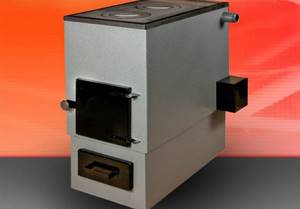
Some models have additional elements:
- A heating element for a 2 kW heating boiler, equipped with a thermostat and a temperature limiter;
- a draft regulator that allows you to automatically regulate the flow of air into the combustion chamber of the device.
In the event of a breakdown, heating elements for heating boilers can be replaced with new products.
At the stage of designing a heating system for a house or apartment, you should carefully consider options for its creation that will save the family budget and ensure coziness and comfort.
Flaws
A heating element with a thermostat for heating also has disadvantages. But the type of equipment should be taken into account. If the coil burns out, it will not be possible to repair the heating element. With prolonged use, scale appears, which affects heat transfer. Customer reviews confirm the presence of negative aspects of the equipment.
Hard water reduces service life. Dry types of equipment are not considered universal. They are created for specific types of broilers. Therefore, during repairs, it can only be replaced with a similar element. Experts advise using the device correctly, then it will not require repair or replacement.
What affects the price?
A heating element for water with a thermostat differs in cost depending on its type and modification. The price of open devices is low. This is a more accessible heat source, especially if the body is made of steel.
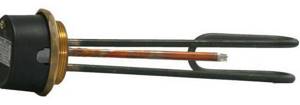
Dry devices that have an unfilled flask are available at an affordable price. Heating elements with quartz fillers are considered more expensive. It should be taken into account that service prices also depend on the cost of the equipment.
Choice
It is necessary to choose the right heating element for a radiator with a thermostat, as well as for other purposes. Usually the purpose, amount of electricity used, heating mode, and installation option are taken into account.
When purchasing, you need to inspect the device body. Copper appliances with a brass base are more expensive and have a longer lifespan compared to stainless steel. It is important to look at the symbols indicated on the case. If the letter “P” is indicated before the voltage indicator of 220V, then this indicates the possibility of using water and slightly alkaline solutions.
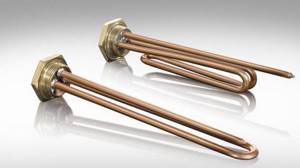
For domestic use, experts recommend using electric heating elements with a thermostat with a power of no more than 2.5 kW. The remaining devices are used for spacious rooms. A heating element with a 2 kW thermostat will be most suitable for a home. There must be thermal protection. It should be taken into account that due to voltage fluctuations and hard water, the operation of the device deteriorates. If any malfunction is detected, experts advise replacing the device.
Pros and cons of radiator heating elements
Tubular-type electric heaters make it possible to assemble a practical and fairly efficient heating system for main or additional heating.
The advantages of the devices include:
- Extreme ease of installation. Every novice master can handle this job.
- The low cost of the device, however, refers to the price of one heating element, without additional equipment.
- Greater reliability compared to oil radiators. In addition, batteries with heating elements are repairable. If the equipment fails, it will be enough to replace the heater.
- Availability of additional options and functionality.
- Possibility of automatic control of the heating system, but this will require additional equipment.
We have listed the main advantages of radiator heating elements; we will consider their significant disadvantages. There are quite a lot of them. First of all, these are impressive operating costs, which is explained by the high cost of electricity. They can be reduced if the heating system control is fully automated.
In this case, the heating elements will be switched on only after the room temperature drops to a certain minimum value. And turn off when the temperature defined as comfortable is reached. Working in this mode is as economical as possible.

The simplest radiator heating elements in design are not equipped with automatic control. To automate such a system, you will need to purchase additional equipment
However, automation equipment will require financial investment. If we consider purchasing a heating element complete with a radiator and automation, the cost of such a kit will be much higher than the price of an electric convector or an oil radiator.
But at the same time, in terms of the level of comfort provided, the latter are in no way inferior, and in some ways even superior to radiators with heating elements. For example, the latter require permanent installation, while electric convectors and oil radiators are more mobile and compact.
In addition, like any other electrical device, heating elements generate a magnetic field during operation. Its danger to the body has not been proven, nor has its safety. Therefore, it is worth attributing the presence of such a field to the negative qualities of devices, because they are mounted in radiators, that is, they are in close proximity to people.
In other heating systems powered by electricity, this disadvantage is to some extent leveled out. For example, electric boilers are located in non-residential premises where human presence is short-term.
One of the most significant disadvantages of radiator heating elements is their relatively low efficiency. If we compare it with the efficiency of traditional systems operating with liquid coolant, it will be significantly lower.
This is due to the fact that in the first case the coolant moves at a fairly high speed. Thanks to this, the radiator warms up quickly and completely.
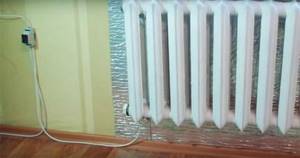
To increase the heat transfer of radiators equipped with heating elements, you can cover the wall on which the device is mounted with a reflective screen made of foil. Thermal radiation will only move into the room
The functioning of the heating element is not able to provide such a high speed. As a result, the heating of the battery case will be uneven. The temperature at the bottom will be much higher than at the top.
Considering that, for safety reasons, the battery should not be allowed to heat up above +70ºС, such a temperature will only be present in the lower part of the radiator, where the heating element is located. Consequently, in order to prevent overheating of the equipment, it will be necessary to reduce its power by about a third.





